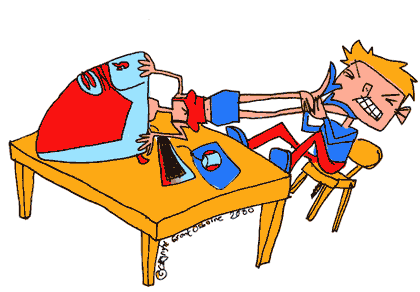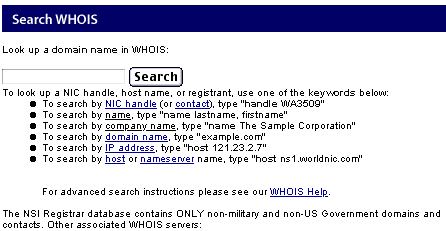Graphics and the Internet
Copyright
Welcome to a new ATPM series, “Graphics and the Internet.” We’ll be looking at the various issues involved in creating images for the Web. If you have any questions, comments, or anything you’d like to see discussed in this series, please e-mail me at gosborne@atpm.com.
“Hold on a minute! I thought this was supposed to deal with Web graphics. What’s the issue of copyright got to do with all this?”
 Quite a lot, really. First of all, let’s play a game. Go to any Web site—for example,
the ATPM Web site. Drag the ATPM logo to your desktop. That was easy, wasn’t it? Want another go? Why not log on to the
Buffy the Vampire Slayer Web site. See that picture of Sarah Michelle Gellar? Let’s drag her to your desktop, too. Simple!
Quite a lot, really. First of all, let’s play a game. Go to any Web site—for example,
the ATPM Web site. Drag the ATPM logo to your desktop. That was easy, wasn’t it? Want another go? Why not log on to the
Buffy the Vampire Slayer Web site. See that picture of Sarah Michelle Gellar? Let’s drag her to your desktop, too. Simple!
Well, that was useful, wasn’t it? If you’ve been playing the game, you should now have a copy of the ATPM logo and a nice picture of Ms. Gellar. Oh, and—um—I’ve just made you break the law.
“Oh, thanks a lot! How did I break the law?”
OK, but first drag the ATPM logo and the Buffy picture to your Trash can and empty it.
“Done!”
Good! You’ve destroyed the evidence! The copyright laws of most countries protect artists, and anyone else who creates something, against the unauthorized duplication of their work. A moment ago, we made copies of the ATPM logo and Sarah Michelle Gellar. The reason I chose the Buffy picture will become apparent later. I chose the ATPM logo for the free advertising!
“What’s the issue of copyright all about, then?”
Well, without copyright laws, you or I could create a piece of work, spending lots of time and money on it, only to have some evil person copy the work and use it for any purpose they saw fit, without any payment or credit to the creator. Copyright laws make it illegal for this to happen.
Without copyright laws, writers, artists, musicians, and other creative people would be discouraged from creating work, as anyone could profit from this work. Without copyright laws, we might never have had Steven King, Andy Warhol, or Alanis Morrisette.
“No Alanis Morrisette! That’s a nice thought! Are you going to tell me how this relates to my Web site? I’m trying to learn about graphics here.”
The Internet (and in particular, the World Wide Web) is often thought of as a “Big Freebie,” and to a certain extent this is true. There’s a vast amount of information out there, available for zilch. You can find out what’s happening in the world, do research for a project, or watch some hamsters dance up and down.
Because of this apparent freedom of information, many people think that the Internet is easy pickings. But the fact that you can drag it to your desktop and stick it on your Web site doesn’t make it right. Along the same lines, you could go into a shop, take a few CDs without paying, then sell them to a third party who’ll buy with no questions asked.
Copyright laws protect an artist’s right to several things, such as reproduction, distribution, display (in galleries, etc.), adaptation, and performance (of plays, movies, etc.). If you breach one of those rights, then you’re infringing on the artist’s copyright.
“OK, what if I ‘borrow’ a button from Amazon’s Web site and credit Amazon for the image?”
No, don’t do it.
“What if I ‘borrow’ an image of Sarah Michelle Gellar, give credit, and provide a link back to their site?”
No, you cannot use any person’s or company’s image without written permission to do so. Imagine you’ve spent hours on your Web site graphics, giving your site a unique look. How would you feel if one day you found another site featuring your graphics? Even if they had credited you, the unique look that your site once had has been lost. On a similar note, if you’ve constructed a business site and you’ve taken images from another site, how honest and trustworthy will your business look to potential clients?
“OK, I can understand not taking images from personal pages, as these people have spent a lot of time on these pages. But companies like Yahoo! and Fox have loads of money—they aren’t going to miss a few images taken here and there. And besides, I’ve seen millions of Web sites with pictures taken from Fox’s official Buffy site.”
You’re right. Fox, Yahoo!, Disney, and the like have stacks of cash—they also have some very good lawyers! Your second point is right too. There are lots of fan sites out there, featuring Buffy pictures and the like—and right now many of these sites are receiving a certified letter from Fox’s lawyers asking them to remove those images or face a copyright infringement suit. A similar thing happened in 1997 when Fox got heavy with the X-files fan sites.

“Whoa! That’s heavy! So what, exactly, am I supposed to put on my fan site?”
Admittedly, it’s difficult. Let’s say, for example, we have a Tom Jones fan site. We can’t use any images we haven’t created ourselves.
- So we can’t use official publicity shots. We would have to get in touch with Tom Jones’s record company, or whoever owns the rights to these pictures.
- We can’t use shots from magazines. Again, we would need to get permission from the magazine and/or photographer.
- No copying of articles from magazines. Again, get permission from the magazine and/or author.
- We can’t reproduce Tom Jones’s lyrics. We would need to seek permission from the publisher. (I know these last two points aren’t related to graphics, but I feel it’s important to include them.)
This isn’t an exhaustive list of what you can’t use, but it should just be enough to give you an idea.
“What can I include, then? This Tom Jones site is going to be a bit dull!”
You can basically include anything that you’ve created yourself or have permission to use. This may include:
- The photo you took of Tom Jones when you met him on holiday. (Note, however, that in the US and some other countries you may need to obtain permission whenever you reproduce someone’s likeness for any commercial purpose, and most non-commercial purposes, regardless of whether you own the copyright. This is a different issue from copyright, so I won’t be covering this here. Seek legal advice for more information.)
- A picture you’ve drawn of Tom Jones.
- Any written work you’ve produced about Tom Jones.
One thing I’ll say about written work is that although you own the copyright to anything you write, you still have to watch that you’re not publishing anything libelous, or infringing anyone’s trademarks. (For example, Mickey Mouse is a trademark of Disney.) These are different matters from copyright, so I won’t go into these here.
There are also “Fair Use” clauses to most countries’ copyright laws, which are, unfortunately, not very clear-cut. Such clauses generally allow you to quote small parts of a work, for the purpose of, for example, a review or comment. This is the part of the law that allows Amazon to print pictures of album covers on its site.
I admit this all makes it difficult for anyone who runs a fan site and wants to stay on the right side of the law. It’s a difficult area. One good thing, though, is that your site will have lots of original material. This will makes it a site worth visiting, and make it stand out from others.
“What can I do, though? I can’t draw or anything, and I really want to use that button from that Web site.”
You have a few options. Why not send an e-mail to the webmaster of that site? Explain that you like the button, that you’d like to use it on your site, and that you’ll provide a link and credit. You may be surprised. Many Webmasters will be flattered and say, “Go ahead!”
When I’m not writing and directing graphics for ATPM, I draw caricatures of celebrities. I put these up on my own Web site for people to look at. Occasionally, other webmasters e-mail me and ask if they can use my (for example) Britney Spears caricature on their Web site. Most of the time, I’ll say “Yes” on the condition that they credit me and provide a link. But if I find one of my images on a Web site where the webmaster hasn’t sought permission, I’ll be on them like a ton of bricks. (We’ll be covering the protection of your own copyright later.) So just ask. They may say no, but there’s no harm in trying.
“That’s all very well with somebody’s homepage, but I don’t think Fox will let me use their Buffy pictures.”
No, probably not. But remember, Fox doesn’t own the right to every picture of Sarah Michelle Gellar or Anthony Giles Head. Magazines will often carry articles and features on Sarah Michelle Gellar, where they have some lovely photographs of Ms. Gellar. Why not contact the magazine and ask their permission to use their pictures? A magazine isn’t as likely to allow you to use their images as keenly as an amateur webmaster, but persevere.
In your request, make it clear that you don’t intend to make a large profit from these pictures or your Web site (but only say this if it’s true). Make it clear that you’ll credit the photographer and magazine, and provide any links to any relevant Web sites. Make sure that the letter is professional looking, too. This will help your cause. Again, you may have no luck, but just keep trying—one day you may hit the jackpot!
“OK, I’m convinced. What if I’ve created some of my own work. How can I stop others from ‘borrowing’ it?”
There are a few things you can do, but due to the nature of the Web, a lot of it boils down to trust.
One important thing you can do is put a copyright notice on every Web page and every large image. Although you own the copyright to any work you create the moment you create it, it’s still important to include the copyright notice. In most countries, it may not be needed, but in other countries, the lack of a copyright notice can make your work “fair game.” As the Web is world wide, your best bet is to cover all eventualities.
A copyright notice consists of the name of the copyright owner, the date of first publication, and either the word copyright or the © symbol. Note that you cannot use (c) instead of ©—this is fairly tempting in HTML, I know. You can use the word copyright instead of the symbol, but this may not cover you in all territories.
This doesn’t physically stop people from taking your images, though. There are a few other tricks you can employ. Please note that these won’t stop everyone, but may deter some “casual thieves.”
- Use JavaScript to disable the right mouse button. Okay, I know we don’t have them on our Macs, but the majority of surfers are using Windows-based machines, which use the right mouse button to save images to the desktop.
- Cut the image up into squares, and rebuild them into a table. This will require a bit more effort to rebuild the image into something usable.
- In Photoshop, you can watermark your images with a unique key. You can these use this to prove your ownership, or trace these images, if they turn up elsewhere on the Web.
These are just a few ideas. Again, these such tricks won’t stop people from taking your images altogether, but they can make it that much harder.
US readers may also want to register their work with the Copyright Office. This will give you extra protection, especially if the case goes to court.
“I’ve just seen some of my work on another Web site. What can I do?”
Chances are, the webmaster of the site where you’ve found your image may not realize he’s done something wrong. Initially, write to him explaining that his site contains copyrighted material belonging to you. Ask him politely to remove the images within 14 days, or you will take further action.
“OK then, what’s this further action?”
Well, you may not need to take further action, as this will be enough to make most people remove your images.
If this doesn’t work, you could try writing to the ISP that hosts the site. Most ISPs have a section in their terms and conditions that prohibits the use of copyrighted material on their servers.
Politely write to the ISP, explaining that they are hosting a Web site containing copyrighted material. The ISP will then probably ask the infringer to remove the images or they will stop hosting his site.
Most home page domain names contain the name of the server. If not, enter the domain name (without the “http://www.” part) at Networks Solutions’ WhoIs site. The domain name shows up as unavailable for you to buy, and you’ll be given the name of the domain name owner, his address, and the ISP.

If this still doesn’t work, your only next step is to take legal action. Get a letter from a lawyer and send a copy to the ISP and the infringer. This will stop most people. If not, you can take them to court. However, dragging it through the courts will take up a lot of your money and time, so you’ll have to decide whether it’s worth it.
In summary, if you want to stay out of trouble, the best option is to make everything on your site yourself. If you have no artistic ability, next time we’ll be looking at “creating and obtaining images for your Web site, even if you have no artistic ability.”
More Information
- Copyright
- More information about copyright
- Digital Watermarking
- The Buffy copyright infringement story
- Finding out who owns a domain name
Also in This Series
- PNG · December 2000
- Seven New Deadly Internet Graphic Sins · November 2000
- Seven Deadly Internet Graphic Sins…or Things That Look Really Bad on Web Pages · October 2000
- The Animated GIF · September 2000
- The GIF File Format · August 2000
- Banner Advertisements · July 2000
- JPEGs and JPEG Compression · June 2000
- Help, I Can’t Draw! · May 2000
- Copyright · April 2000
- Complete Archive
Reader Comments (5)
thanks for all thsi neat info. it will help alot when i am creating my websites. and if you have more stuff to learn please email me the links thanks agian,
Add A Comment